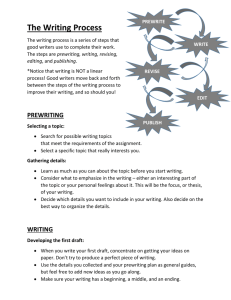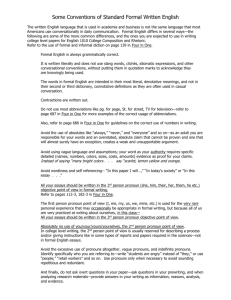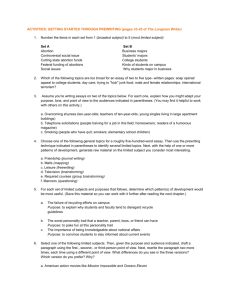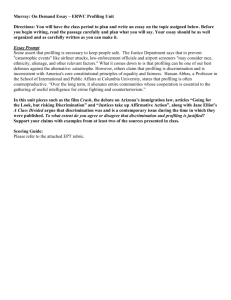Final Exam ReviewBusiness CommunicationBUS 207 Chapter 2
advertisement
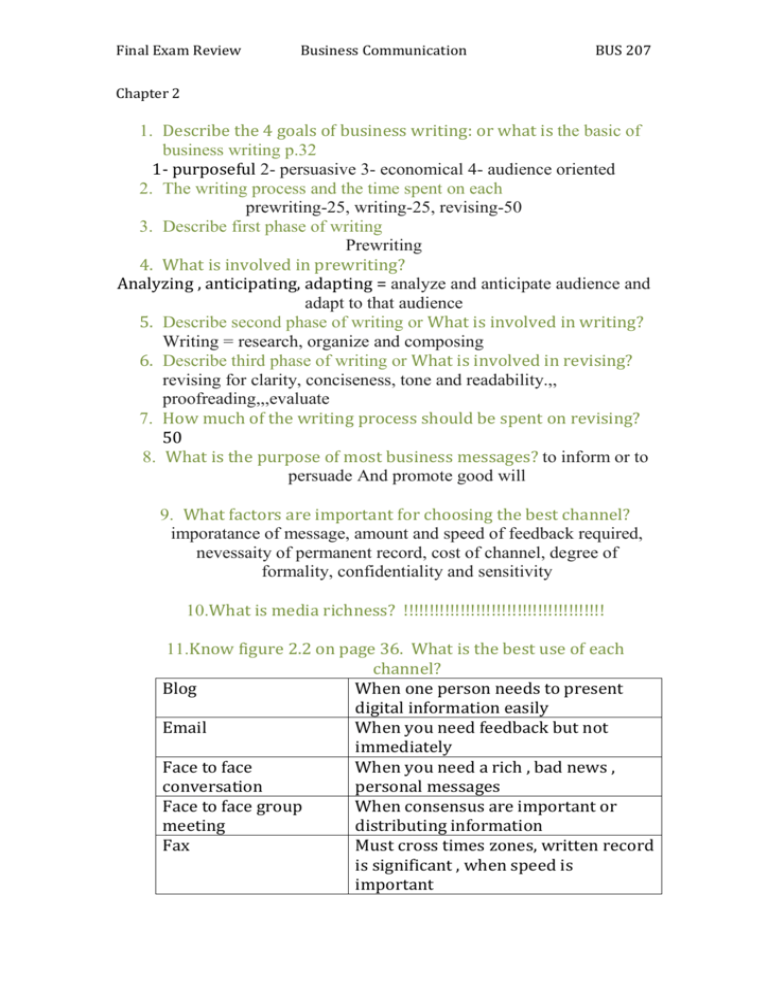
Final Exam Review Business Communication BUS 207 Chapter 2 1. Describe the 4 goals of business writing: or what is the basic of business writing p.32 1- purposeful 2- persuasive 3- economical 4- audience oriented 2. The writing process and the time spent on each prewriting-25, writing-25, revising-50 3. Describe first phase of writing Prewriting 4. What is involved in prewriting? Analyzing , anticipating, adapting = analyze and anticipate audience and adapt to that audience 5. Describe second phase of writing or What is involved in writing? Writing = research, organize and composing 6. Describe third phase of writing or What is involved in revising? revising for clarity, conciseness, tone and readability.,, proofreading,,,evaluate 7. How much of the writing process should be spent on revising? 50 8. What is the purpose of most business messages? to inform or to persuade And promote good will 9. What factors are important for choosing the best channel? imporatance of message, amount and speed of feedback required, nevessaity of permanent record, cost of channel, degree of formality, confidentiality and sensitivity 10.What is media richness? !!!!!!!!!!!!!!!!!!!!!!!!!!!!!!!!!!!!!!! 11.Know figure 2.2 on page 36. What is the best use of each channel? Blog When one person needs to present digital information easily Email When you need feedback but not immediately Face to face When you need a rich , bad news , conversation personal messages Face to face group When consensus are important or meeting distributing information Fax Must cross times zones, written record is significant , when speed is important Final Exam Review Instant message letter memo Phone call Report , proposal wiki Business Communication BUS 207 When you are online and need a quick response When a written record or formality (outside the organization) When your written record or collect information ( within the organization) When you need to deliver information quickly or nonverbal are unimportant When you are delivery considerable data internally or externally When you information must be made available to others 12. What is a secondary audience?!!!!!!!!!!!!!! 13. What is tone?!!!!!!!!!!!!!!!!! 14.List three specific techniques for developing a warm, friendly and conversational tone in business messages. 1- avoid overuse of expressions do not rely on abbreviations 2- avoid IM abbreviations, slangs 3- avoid overly formal statements, long sentences, legal terms, third person construction 15. What is empathy? Why is it important in business writing? P38!!!!!!!!! 16. Why should you include “you” in your writing? Because receivers are most interested in themselves, emphasize the word you to promote audience benefits p38 17. What is positive language? it creates good will, convey more infomation and give more options to receivers 18. Why is it OK to use IM messaging abbreviations (such as BTW or LOL) and happy faces in messages to friends but not OK in business messages.p40 !!!!!!!!!!!!!!!!!!!!!!!!!!!!!!!!!!!!!!! 19. How does profiling the audience help make a business comm deliver its messages? you can identify the proper tone language and channel. after profiling, you can decide whether the receiver will be neutral Final Exam Review Business Communication BUS 207 positive or hostile toward your message. 20.List principles of plain english movement use active voice with strong verbs, dont be afraid of personal pronouns, bring abstractions back to earth, omit purposeless words, use positive expression, prefer short sentence, remove jargon, keep subject, very and obkect close, keep sentence structure parallel 21.What to consider when analyzing purpose and audience indentify purpose, selecting best channel, switching to faster channels, profiling audience, responding to the profile 22. How can a writer make a message audience oriented and make audience benefits? profiling the audience, responding to the profile , empathetic, you view 23. Components in adapting to the task and audience audience benefits you view conversational but professional positive language courteous language inclusive language plain english familiar words 24. Examples of sexist pronouns and nouns pronouns:he, his, her, him, she, nouns: stewardess, fireman, mailman, waitress, waiter
